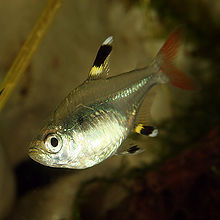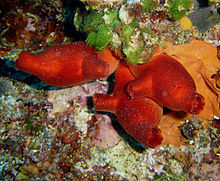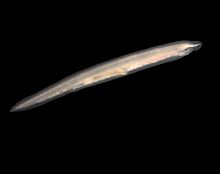
Chordate
Did you know...
SOS Children offer a complete download of this selection for schools for use on schools intranets. Child sponsorship helps children one by one http://www.sponsor-a-child.org.uk/.
| Chordata Temporal range: Early Cambrian – Recent, 540–0Ma |
|
|---|---|
 |
|
| The X-ray tetra ( Pristella maxillaris) is one of the few chordates with a visible backbone. The spinal cord is housed within its backbone. | |
| Scientific classification |
|
| Kingdom: | Animalia |
| Superphylum: | Deuterostomia |
| Phylum: | Chordata Haeckel, 1874 |
| Classes | |
|
See below |
|
Chordates, members of the phylum Chordata, are deuterostome animals possessing a notochord, a hollow dorsal nerve cord, pharyngeal slits, an endostyle, and a post-anal tail for at least some period of their life cycles. Taxonomically, the phylum includes the subphyla Vertebrata, including mammals, fish, amphibians, reptiles, birds; Tunicata, including salps and sea squirts; and Cephalochordata, comprising the lancelets.
The phylum Hemichordata including the acorn worms has been presented as a fourth chordate subphylum, but it now is usually treated as a separate phylum. It, along with the echinoderm phylum, including starfish, sea urchins, and sea cucumbers and their kin, are the chordates' closest relatives. Primitive chordates are known from at least as early as the Cambrian explosion.
There are more than 60,000 living species of chordates, about half of which are bony fish of the class osteichthyes. The world's largest animal, the blue whale, and fastest animal, the peregrine falcon, are chordates.
Overview of affinities
Tunicate larvae have both a notochord and a nerve cord which are lost in adulthood. Cephalochordates have a notochord and a nerve cord (but no brain or specialist sensory organs) and a very simple circulatory system. Craniates are the only subphylum whose members have skulls. In all craniates except for hagfish, the dorsal hollow nerve cord is surrounded with cartilaginous or bony vertebrae and the notochord is generally reduced; hence, hagfish are not universally regarded as vertebrates, though recent DNA comparisons suggest that they are in fact vertebrates. The chordates and three sister phyla, the Hemichordata, the Echinodermata and the Xenoturbellida, make up the deuterostomes, one of the two superphyla that encompass all fairly complex animals.
Attempts to work out the evolutionary relationships of the chordates have produced several hypotheses. The current consensus is that chordates are monophyletic, meaning that the Chordata include all and only the descendants of a single common ancestor which is itself a chordate, and that craniates' nearest relatives are cephalochordates. All of the earliest chordate fossils have been found in the Early Cambrian Chengjiang fauna, and include two species that are regarded as fish, which implies they are vertebrates. Because the fossil record of chordates is poor, only molecular phylogenetics offers a reasonable prospect of dating their emergence. However, the use of molecular phylogenetics for dating evolutionary transitions is controversial.
It has also proved difficult to produce a detailed classification within the living chordates. Attempts to produce evolutionary " family trees" give results that differ from traditional classes because several of those classes are not monophyletic. As a result, vertebrate classification is in a state of flux.
Origin of name
Although the name Chordata is often attributed to William Bateson (1885), it was already in prevalent use in by 1880. Ernst Haeckel described a taxon comprising tunicates, cephalochordates, and vertebrates in 1866. Though he used the German vernacular form, it is allowed under the ICZN code because of its subsequent latinization.
Definition
Chordates form a phylum of creatures that are based on a bilateral body plan, and is defined by having at some stage in their lives all of the following:
- A notochord, in other words a fair stiff rod of cartilage that extends along the inside of the body. Among the vertebrate sub-group of chordates the notochord develops into the spine, and in wholly aquatic species this helps the animal to swim by flexing its tail.
- A dorsal neural tube. In fish and other vertebrates this develops into the spinal cord, the main communications trunk of the nervous system.
- Pharyngeal slits. The pharynx is the part of the throat immediately behind the mouth. In fish the slits are modified to form gills, but in some other chordates they are part of a filter-feeding system that extracts particles of food from the water in which the animals live.
- Post-anal tail. A muscular tail that extends backwards behind the anus.
- An endostyle. This is a groove in the ventral wall of the pharynx. In filter-feeding species it produces mucus to gather food particles, which helps in transporting food to the esophagus. It also stores iodine, and may be a precursor of the vertebrate thyroid gland.
Subdivisions
Craniata
Craniates, one of the three subdivisions of chordates, have distinct skulls - including hagfish, which have no vertebrae. Michael J. Benton comments, "craniates are characterized by their heads, just as chordates, or possibly all deuterostomes, are by their tails."
Most are vertebrates, in which the notochord is replaced by the spinal column , which consists of a series of bony or cartilaginous cylindrical vertebrae, generally with neural arches that protect the spinal cord and with projections that link the vertebrae. Hagfish have incomplete braincases and no vertebrae, and are therefore not regarded as vertebrates, but as members of the craniates, the group from which vertebrates are thought to have evolved. The position of lampreys is ambiguous. They have complete braincases and rudimentary vertebrae, and therefore may be regarded as vertebrates and true fish. However, molecular phylogenetics, which uses biochemical features to classify organisms, has produced both results that group them with vertebrates and others that group them with hagfish.
Urochordata: tunicates
Most tunicates appear as adults in two major forms, both of which are soft-bodied filter-feeders that lack the standard features of chordates: "sea squirts" are sessile and consist mainly of water pumps and filter-feeding apparatus; salps float in mid-water, feeding on plankton, and have a two-generation cycle in which one generation is solitary and the next forms chain-like colonies. However, all tunicate larvae have the standard chordate features, including long, tadpole-like tails; they also have rudimentary brains, light sensors and tilt sensors. The third main group of tunicates, Appendicularia (also known as Larvacea) retain tadpole-like shapes and active swimming all their lives, and were for a long time regarded as larvae of sea squirts or salps. Because of their larvae's long tails tunicates are also called urochordates ("tail chordates").
Cephalochordata: lancelets
Cephalochordates are small, "vaguely fish-shaped" animals that lack brains, clearly defined heads and specialized sense organs. These burrowing filter-feeders comprise the earliest-branching chordate sub-phylum.
Closest nonchordate relatives
Hemichordates
Hemichordates ("half (½) chordates") have some features similar to those of chordates: branchial openings that open into the pharynx and look rather like gill slits; stomochords, similar in composition to notochords, but running in a circle round the "collar", which is ahead of the mouth; and a dorsal nerve cord — but also a smaller ventral nerve cord.
There are two living groups of hemichordates. The solitary enteropneusts, commonly known as "acorn worms", have long proboscises and worm-like bodies with up to 200 branchial slits, are up to 2.5 metres (8.2 ft) long, and burrow though seafloor sediments. Pterobranchs are colonial animals, often less than 1 millimetre (0.039 in) long individually, whose dwellings are interconnected. Each filter feeds by means of a pair of branched tentacles, and has a short, shield-shaped proboscis. The extinct graptolites, colonial animals whose fossils look like tiny hacksaw blades, lived in tubes similar to those of pterobranchs.
Echinoderms
Echinoderms differ from chordates and their other relatives in three conspicuous ways: they possess bilateral symmetry as larvae and in adulthood they have radial symmetry, meaning their body pattern is shaped like a wheel; they have tube feet; and their bodies are supported by skeletons made of calcite, a material not used by chordates. Their hard, calcified shells keep their bodies well protected from the environment, and these skeletons enclose their bodies, but are also covered by thin skins. The feet are powered by another unique feature of echinoderms, a water vascular system of canals that also functions as a "lung" and are surrounded by muscles that act as pumps. Crinoids look rather like flowers, and use their feather-like arms to filter food particles out of the water; most live anchored to rocks, but a few can move very slowly. Other echinoderms are mobile and take a variety of body shapes, for example starfish, sea urchins and sea cucumbers.
Origins
The majority of animals more complex than jellyfish and other Cnidarians are split into two groups, the protostomes and deuterostomes, and chordates are deuterostomes. It seems very likely the 555 million-year-old Kimberella was a member of the protostomes. If so, this means the protostome and deuterostome lineages must have split some time before Kimberella appeared — at least 558 million years ago, and hence well before the start of the Cambrian 541 million years ago. The Ediacaran fossil Ernietta, from about 549 to 543 million years ago, may represent a deuterostome animal.
Fossils of one major deuterostome group, the echinoderms (whose modern members include starfish, sea urchins and crinoids), are quite common from the start of the Cambrian, 542 million years ago. The Mid Cambrian fossil Rhabdotubus johanssoni has been interpreted as a pterobranch hemichordate. Opinions differ about whether the Chengjiang fauna fossil Yunnanozoon, from the earlier Cambrian, was a hemichordate or chordate. Another fossil, Haikouella lanceolata, also from the Chengjiang fauna, is interpreted as a chordate and possibly a craniate, as it shows signs of a heart, arteries, gill filaments, a tail, a neural chord with a brain at the front end, and possibly eyes — although it also had short tentacles round its mouth. Haikouichthys and Myllokunmingia, also from the Chengjiang fauna, are regarded as fish. Pikaia, discovered much earlier but from the Mid Cambrian Burgess Shale, is also regarded as a primitive chordate. On the other hand fossils of early chordates are very rare, since non-vertebrate chordates have no bones or teeth, and only one has been reported for the rest of the Cambrian.
| Deuterostomes |
|
|||||||||||||||||||||||||||||||||
|
|
The evolutionary relationships between the chordate groups and between chordates as a whole and their closest deuterostome relatives have been debated since 1890. Studies based on anatomical, embryological, and paleontological data have produced different "family trees". Some closely linked chordates and hemichordates, but that idea is now rejected. Combining such analyses with data from a small set of ribosome RNA genes eliminated some older ideas, but open the possibility that tunicates (urochordates) are "basal deuterostomes", surviving members of the group from which echinoderms, hemichordates and chordates evolved. Some researchers believe that, within the chordates, craniates are most closely related to cephalochordates, but there are also reasons for regarding tunicates (urochordates) as craniates' closest relatives. One other phylum, Xenoturbellida, appears to be basal within the deuterostomes, closer to the original deuterostomes than to the chordates, echinoderms and hemichordates.
Since chordates have left a poor fossil record, attempts have been made to calculate the key dates in their evolution by molecular phylogenetics techniques - by analyzing biochemical differences, mainly in RNA. One such study suggested deuterostomes arose before 900 million years ago and the earliest chordates around 896 million years ago. However, molecular estimates of dates often disagree with each other and with the fossil record, and their assumption that the molecular clock runs at a known constant rate has been challenged.
Classification
Taxonomy


The following schema is from the third edition of Vertebrate Palaeontology. The invertebrate chordate classes are from Fishes of the World. While it is structured so as to reflect evolutionary relationships (similar to a cladogram), it also retains the traditional ranks used in Linnaean taxonomy.
- Phylum Chordata
- Subphylum Tunicata (Urochordata) — (tunicates; 3,000 species)
- Class Ascidiacea (sea squirts)
- Class Thaliacea (salps)
- Class Appendicularia (larvaceans)
- Class Sorberacea
- Subphylum Cephalochordata (Acraniata) — (lancelets; 30 species)
- Class Leptocardii (lancelets)
- Subphylum Vertebrata ( Craniata) (vertebrates — animals with backbones; 57,674 species)
- Infraphylum incertae sedis
- Superclass ' Agnatha' paraphyletic (jawless vertebrates; 100+ species)
- Class Myxini (hagfish; 65 species)
- Class Petromyzontida (lampreys)
- Class † Conodonta
- Superclass ' Agnatha' paraphyletic (jawless vertebrates; 100+ species)
- Infraphylum Gnathostomata ( jawed vertebrates)
- Superclass incertae sedis
- Class † Placodermi (Paleozoic armoured forms)
- Class Chondrichthyes (cartilaginous fish; 900+ species)
- Class † Acanthodii (Paleozoic "spiny sharks")
- Superclass Osteichthyes (bony fish; 30,000+ species)
- Class Actinopterygii (ray-finned fish; about 30,000 species)
- Class Sarcopterygii (lobe-finned fish: 8 species)
- Superclass Tetrapoda (four-limbed vertebrates; 28,000+ species)
- Superclass incertae sedis
- Infraphylum incertae sedis
- Subphylum Tunicata (Urochordata) — (tunicates; 3,000 species)
Phylogeny
| Chordates | |||||||||||||||||||||||||||||||||||||||||||||||||||||||||||||||||||||||||||||||||||||||||||||||||||
|
|
|||||||||||||||||||||||||||||||||||||||||||||||||||||||||||||||||||||||||||||||||||||||||||||||||||
Cladogram of the Chordate phylum. Lines show probable evolutionary relationships, including extinct taxa, which are denoted with a dagger, †. Some are invertebrates. The positions (relationships) of the Lancelet, Tunicate, and Craniata clades are as reported in the scientific journal Nature.
|







